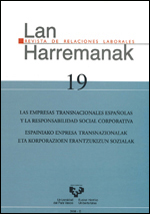Responsabilidad Social empresarial: un ámbito de necesaria intervención sindical
##plugins.themes.bootstrap3.article.main##
##plugins.themes.bootstrap3.article.sidebar##
Resumen
Superados o desbordados los intentos de limitar la Responsabilidad Social Empresarial a una operación de marketing, la RSC es ya un instrumento para la gobernanza mundial en el cumplimiento de las normas sociales y medioambientales. Lo esencial será su exigibilidad y la verificación del cumplimiento de los compromisos empresariales, tanto si son resultado de Acuerdos Marco Internacionales con las Federaciones Sindicales Internacionales, como si son códigos de conducta asumidos unilateralmente o se trata, simplemente, de afirmaciones de buena conducta contenidas en las memorias empresariales. La también exigible transparencia debería traducirse en publicitar la lista de filiales, proveedores y subcontratas que constituyen las cadenas de producción y distribución de las multinacionales, así como los resultados de las auditorías y otras formas de verificación. Desde estas consideraciones, se formula en este artículo la necesidad de intervención de uno de los stakeholders, los sindicatos, partiendo de las experiencias de la Federación de Industrias Textil-Piel, Químicas y Afines de Comisiones Obreras. En la crisis que vivimos, una de cuyas causas es la «irresponsabilidad» de importantes ámbitos empresariales, la Responsabilidad Social de las Empresas, sin constituir la solución de esta grave coyuntura, debería adquirir un mayor significado.
Cómo citar
##plugins.themes.bootstrap3.article.details##
Los autores que publican en la revista "Lan Harremanak" lo hacen de acuerdo con los siguientes términos:
1. Los autores conservan los derechos de autor de sus trabajos, cediendo a la revista "Lan Harremanak" el derecho a la primera publicación de su artículo.
2. La editorial UPV/EHU Press es copropietaria de los derechos de autor, con el fin de proteger el uso legítimo del artículo publicado y el cumplimiento de los términos CC.
3. Los artículos publicados están sujetos a una licencia CC-BY de Creative Commons (a menos que se indique lo contrario) que permite a terceros compartir el artículo, con la condición de que se especifique el autor y la fuente cuando se reproduce el material.
4. Los autores pueden celebrar otros acuerdos de licencia no exclusivos con respecto a la versión publicada de su trabajo (por ejemplo, depositarlo en un repositorio institucional o volver a publicarlo como un volumen monográfico), siempre que el autor y la fuente reciban el crédito apropiado.
5. La difusión de los artículos enviados a través de Internet está permitida y recomendada (por ejemplo, en repositorios institucionales y/o en la página web del investigador), tanto antes como durante el proceso de envío, ya que esto puede generar diálogos interesantes y también aumentar las citas a la eventual publicación.

